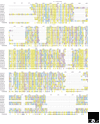The septins
- PMID: 14611653
- PMCID: PMC329110
- DOI: 10.1186/gb-2003-4-11-236
The septins
Abstract
The septins are guanine-nucleotide binding proteins that mostly form filaments. They are important in cytokinesis and also have roles in sporulation in yeasts and embryonic development and in the nervous system in animals.
Figures


References
-
- Hartwell LH. Genetic control of the cell division cycle in yeast. IV. Genes controlling bud emergence and cytokinesis. Exp Cell Res. 1971;69:265–276. The original report describing the isolation of the septin mutants. - PubMed
-
- Longtine MS, Demarini DJ, Valencik ML, Al-Awar OS, Fares H, De Virgilio C, Pringle JR. The septins, roles in cytokinesis and other processes. Curr Opin Cell Biol. 1996;8:106–119. doi: 10.1016/S0955-0674(96)80054-8. The first comprehensive review on the septin family, including important previously unpublished observations and insights based on original data. - DOI - PubMed
Publication types
MeSH terms
Substances
LinkOut - more resources
Full Text Sources
Molecular Biology Databases

